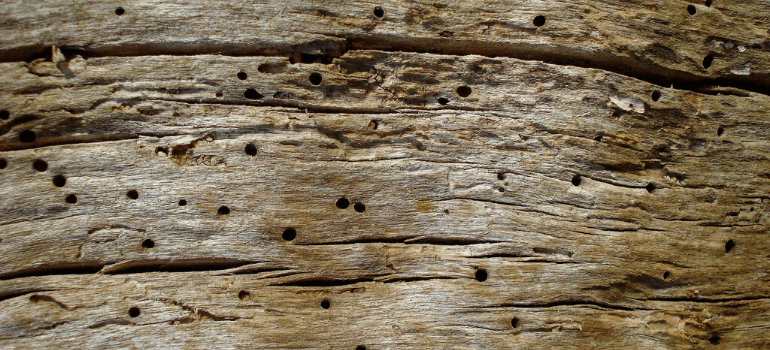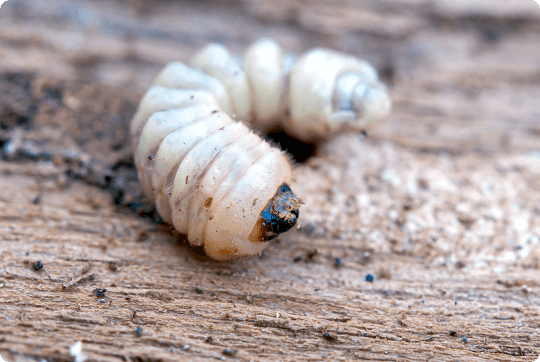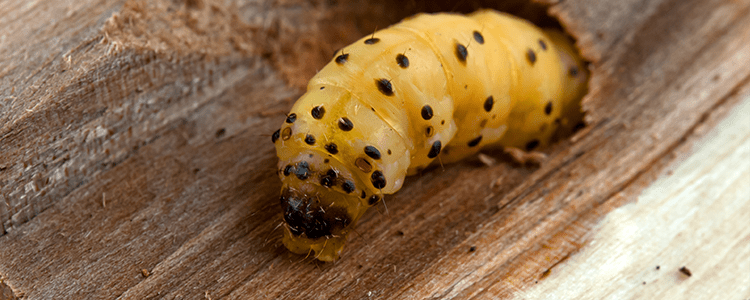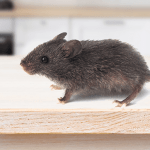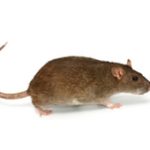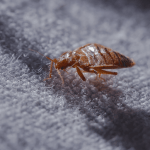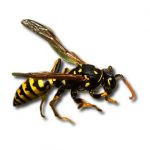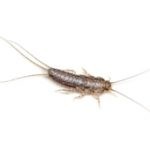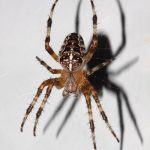Woodworm
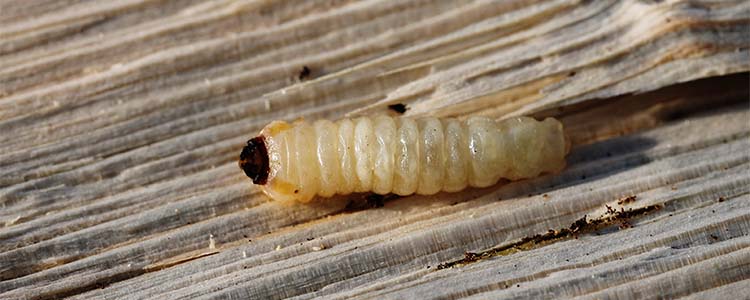
Woodworms are the larvae of various species of wood-boring beetles. When people say “woodworm”, they usually refer to the beetles’ larval form. Despite the name, they’re not actually worms at all. The most common culprits in the UK are the common furniture beetle (Anobium punctatum), but there are several other species, each preferring different types of wood and environmental conditions. Adult beetles are about 60 mm long and have elytron—a pair of hardened forewings.
What Do Woodworms Look Like?
Woodworms, in their larval stage, are small, creamy-white, and C-shaped grubs with a slightly darker head. They’re usually only a few millimetres long—typically between 2 to 5mm depending on the species. Because they live inside the wood woodworms are now visible to the eye, unless the wood is broken open.
More often, people notice the evidence of woodworms rather than the larvae themselves.
How to Spot a Woodworm Infestation
There are several signs of a woodworm infestation:
- Some larvae make a distinct scratching noise while feeding.
- Another easily distinguishable sound is the knocking Death Watch Beetles make when looking for a partner.
- Insect faeces—also known as frass—appear near or under exit holes. They look like white, fine powder, and smell like groundwood (which, essentially, they are).
- The exit holes are another possible sign—they are small, about 2 mm in diameter, and have irregular, circular shapes.
Life Cycle
Woodworms go through 4 stages in their life. First, an adult woodboring beetle lays eggs on damp wood. When the eggs hatch, a larva emerges. The larva burrows in the wood, where it remains for several years. It tunnels and feeds on timber. The average woodboring beetle remains in the larval stage for 4 years.
After that, the larva returns close to the surface of the wood and turns into a pupa, from which the adult beetle emerges. The adult furniture beetles, the final stage of a woodworm’s life cycle, fly toward light sources such as windows and UV lights as soon as they chew their way through the wood.
Identification of Woodworm Beetles in the UK
Death Watch Beetle (Xestobium rufovillosum)
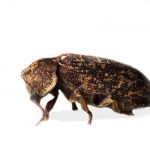 The Death Watch Beetle is native to Britain and prefers hard timbers such as oak, chestnut and beech. The wood must be partially infected by fungi for a beetle to lay eggs on it. Its body is oval in shape and dark grey in colour. On average, an adult beetle is 7 mm long. The larva is creamy-white, with a yellow head and black mandibles. It is also the largest of all woodworm—up to 11 mm long. This woodborer rarely uses its wings and almost never flies.
The Death Watch Beetle is native to Britain and prefers hard timbers such as oak, chestnut and beech. The wood must be partially infected by fungi for a beetle to lay eggs on it. Its body is oval in shape and dark grey in colour. On average, an adult beetle is 7 mm long. The larva is creamy-white, with a yellow head and black mandibles. It is also the largest of all woodworm—up to 11 mm long. This woodborer rarely uses its wings and almost never flies.
Image by: Gilles San Martin
Common Furniture Beetle (Anobium punctatum)
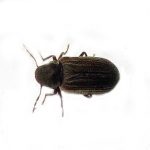 The adult beetle reaches only 4 mm in length. They also tend to fly, especially in warm climates and in sunny weather. They spend 3-5 years in larval form. Unlike most woodboring beetles, the Common Furniture Beetle attacks only well-seasoned lumber with the bark removed. As the name suggests, the greyish-white larvae infest furniture, structural timbering, wooden panelling and flooring.
The adult beetle reaches only 4 mm in length. They also tend to fly, especially in warm climates and in sunny weather. They spend 3-5 years in larval form. Unlike most woodboring beetles, the Common Furniture Beetle attacks only well-seasoned lumber with the bark removed. As the name suggests, the greyish-white larvae infest furniture, structural timbering, wooden panelling and flooring.
Image by: David Short
Old-House Borer (Hylotrupes bajulus)
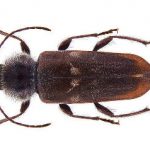 This is the only woodboring beetle that infests the same wood it emerged from. It is not native to Britain and came from Europe. The adult of this beetle is 8-25 mm long and black or brown in colour. The body is slender and long, with distinct antennae, curved at the end. The larvae can tunnel for up to 11 years before emerging. Like the Common Furniture Beetle, the Old-House Borer flies freely in warm, sunny weather.
This is the only woodboring beetle that infests the same wood it emerged from. It is not native to Britain and came from Europe. The adult of this beetle is 8-25 mm long and black or brown in colour. The body is slender and long, with distinct antennae, curved at the end. The larvae can tunnel for up to 11 years before emerging. Like the Common Furniture Beetle, the Old-House Borer flies freely in warm, sunny weather.
Image by: Udo Schmidt
Powder Post Beetle (Lyctinae)
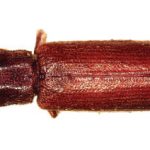 It infests hardwoods such as oak, walnut, beech, ash and elm. The adults have red to light brown bodies, oval in shape. They reach 4-7 mm in length. Although they have a relatively short lifespan (about a year), they cause so much damage often infested surfaces crumble to the touch—hence their name.
It infests hardwoods such as oak, walnut, beech, ash and elm. The adults have red to light brown bodies, oval in shape. They reach 4-7 mm in length. Although they have a relatively short lifespan (about a year), they cause so much damage often infested surfaces crumble to the touch—hence their name.
Image by: Wisut Sittichaya
Woodworm Damage
Woodworm infestations can cause a range of problems, especially if left untreated. The main issues include:
- Structural damage – As the larvae tunnel through timber, they weaken it from within. Over time, this can compromise the integrity of furniture, flooring, beams, and even the structural framework of a building.
- Aesthetic damage – The exit holes and crumbling wood can spoil the appearance of wooden items, making antique furniture or decorative pieces look worn and damaged.
- Spread of infestation – If not dealt with promptly, woodworm can spread to other wooden areas or items within a property, increasing the extent—and cost—of the damage.
- Decreased property value – Severe infestations can affect a home’s value or delay a sale, as potential buyers may be wary of existing or past woodworm problems.
Learn how to get rid of the woodworm infestation
Is woodworm harmful to humans?
The good news is that woodworm isn’t directly harmful to people. The larvae don’t bite or sting, and the adult beetles are completely harmless too. So, there’s no need to worry about them creeping around causing you any physical harm. That said, there are a couple of indirect things to keep in mind.
As mentioned, if woodworm gets into structural parts of your home, it can weaken them over time, which could eventually become a safety issue. Also, the frass they leave behind might cause mild irritation for people with allergies or breathing conditions, though that’s pretty rare.
So while the bugs themselves won’t hurt you, the damage they leave behind definitely can if it goes unchecked.
What to Do in Case of a Woodworm Infestation
Only an experienced woodworm specialist is able to treat an infestation. The good news is that once exterminated, wood beetle larvae would have a hard time infesting the treated timber for years. Although the procedure is difficult, it is fairly simple. A special paste is injected into the exit holes, which prevents larvae from escaping and causes them to suffocate. If possible, woodworm close to the surface will be removed.
Want a professional to inspect your home?
Keep in mind that we only aim to provide some useful information about woodworms in general. We cannot guarantee that the bugs you’re dealing with corresponds to the same description and are exactly the same.



